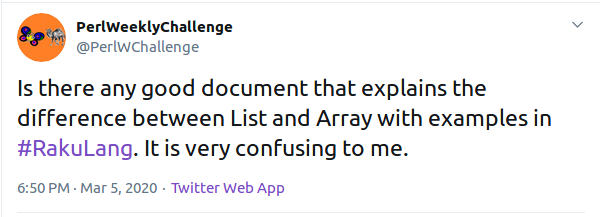I am really enjoying the weekly challenges, specially doing in Raku. The point of blogging is also about sharing my fight with Raku. I hardly write anything about my Perl solution as I don’t see anything new to talk about. Having said that, I still go for Perl first as it is my first love and will remain so rest of my life. Even today, my brain is so tuned to Perl, every ideas come in form and shape of Perl only. I started contributing in the Week #46. I could only find time to do Perl solutions in the Week #46. The following Week #47 was the same as I didn’t get to do Raku. It was the Week #48 when I managed to find time to do both Perl and Raku for the first time. Ever since I have been able to contribute every week in both languages. I would give the credit to the fellow Team PWC member, Ryan Thompson, for helping me with the Perl and Raku reviews.
PERL
Task #1: 3 Sum (Perl)
The 3 Sum task is dealt with brute force method. I must admit, I loved the end result in Perl. It may not be the fastest as far as the performance is concerned but it looked like poetry to me.
#!/usr/bin/perl
use strict;
use warnings;
my @L = (-25, -10, -7, -3, 2, 4, 8, 10);
my $S = $#L;
my $T = 0;
foreach my $i (0 .. $S) {
foreach my $j (0 .. $S) {
next if ($i == $j);
foreach my $k (0 .. $S) {
next if (($k == $i) || ($k == $j));
print sprintf("[%d, %d, %d]\n", $L[$i], $L[$j], $L[$k])
if ($L[$i] + $L[$j] + $L[$k] == $T);
}
}
}
Task #2: Colorful Number (Perl)
The Colorful Number was very fun to solve. Let me confess, when I came up with the challenge, I didn’t realise it was going to be so fun. If you are active on Twitter then you will find out what I am talking about. There was so much informative discussion going on with regard to this task, mostly from the Raku point of view. I followed the conversation very closely as you get to learn so much out of it.Doing the weekly challenges introduced me to the CPAN module List::Util. Having the module handy makes life so easy, is unbelievable. I have high regards to all the contributors and maintainers of CPAN modules. You can’t imagine a life without CPAN. Before I would come up with my own handy method to do the task but not any more.
#!/usr/bin/perl
use strict;
use warnings;
use List::Util 1.45 qw(uniq);
foreach my $i (234 .. 987) {
my @N = split //, $i;
# Only try if all three digits are unique.
next if ( scalar(uniq(@N)) != scalar(@N) );
my @S = ($N[0], $N[1], $N[2], ($N[0] * $N[1]), ($N[1] * $N[2]), ($N[0] * $N[1] * $N[2]));
print "[$i] => [", join(", ", @S), "]\n"
if ( scalar(uniq(@S)) == scalar(@S) );
}
RAKU
Here comes the fun, Perl developer talking about Raku. I must confess that I am still learning the basics. Having said that I feel confident enough to face the challenge. Did you notice one thing, this week challenge relies heavily on the list. So I looked up official Raku documentation to get my head around and find out how to work with list. I noticed there is a class called List in Raku. I also found something similar, a class called Array. At this point, I was confused what is the differene between List and Array in Raku.
I asked for advice on Twitter.

Scimon Proctor replied to my query first.

Followed by another response by Herbert Bollermann

With all the knowledge handy, I was ready to get my hand dirty. I decided to use Array to deal with 3 Sum task. I found handy method elems as described in official documentation.
method elems(Array:D: --> Int:D)
Returns the number of elements in the invocant.
Other than that nothing new to me.
Task #1: 3 Sum (Raku)
#!/usr/bin/env perl6
use v6;
sub MAIN() {
my @L = (-25, -10, -7, -3, 2, 4, 8, 10);
my $S = @L.elems - 1;
my $T = 0;
for 0 .. $S -> $i {
for 0 .. $S -> $j {
next if $i == $j;
for 0 .. $S -> $k {
next if ($k == $i) || ($k == $j);
say "[" ~ @L[$i] ~ ", " ~ @L[$j] ~ ", " ~ @L[$k] ~ "]"
if @L[$i] + @L[$j] + @L[$k] == $T;
}
}
}
}
Task #2: Colorful Number (Raku)
The Colorful number task involved more as compare to the other task. I decided to split the 3 digits number, so looked up in the documentation for the help. I found Str class very handy. There is a method comb() provided by Str class. With the power method chaining of Raku, the line below does the following:
my $j = $i.comb.unique.join;
1) split the number
2) removes duplicate integer
3) joins all back
Other than this, nothing new to talk about except @S.unique.elems, removing duplicate entry from the list and return the count.
#!/usr/bin/env perl6
use v6;
sub MAIN() {
for 234 .. 987 -> $i {
my $j = $i.comb.unique.join;
# Only try if all three digits are unique.
next if $i != $j;
my @N = $i.comb;
my @S = (@N[0], @N[1], @N[2], (@N[0] * @N[1]), (@N[1] * @N[2]), (@N[0] * @N[1] * @N[2]));
say "[$i] => [" ~ @S.join(", ") ~ "]" if @S.unique.elems == @S.elems;
}
}
That’s it for this week. Speak to you soon.
